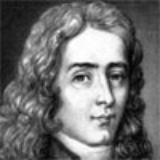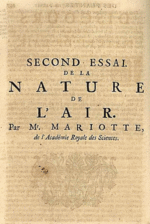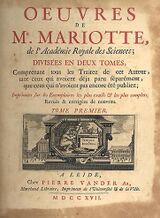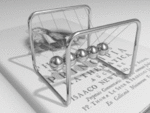Biography:Edme Mariotte
Edme Mariotte (/ˌmɑːriˈɒt/;[1] French: [ɛdmə maʁjɔt]; c. 1620 – 12 May 1684) was a France physicist and priest (Abbé).[2]
Biography
Born in Til-Châtel, Edme Mariotte was the youngest son of Simon Mariotte, administrator at the district Til-Châtel (died 16 Augustus 1652), and Catherine Denisot (died 26 September 1636 due to plague). His parents lived in Til-Châtel and had 4 other children: Jean, Denise, Claude, and Catharine. Jean was administrator in the Parlement of Paris from 1630 till his death in 1682. Denise and Claude, both married, stayed in the Dijon region, where as Catharine married Blaise de Beaubrieul, advisor of king Louis de XIV. Catherine and Blaise lived in the same street 16, perhaps on the same address, where Jean lived.[3] The early life of Edme Mariotte is unknown. His title "Sieur de Chazeuil" was probably inherited from his brother Jean in 1682. It refers to the estate of his father, which was first given to Jean. This estate was in the region Chazeuil.[4][5] It is not clear whether Mariotte spent most of his early life at Dijon, and whether he was prior of St Martin sous Beaune. There are no references to confirm this. In 1668 Colbert invited Mariotte to participate in the "l'Académie des Sciences", the French equivalence of the Royal Society. From that time on he published several articles.

In 1670 Mariotte moved to Paris. The address on a letter found in the Leibniz archive shows that Edme lived in the rue de Bertin-Poirree, near the chapel of the guild of the goldsmiths in the rue des Orfèvres in 1677. Perhaps he lived together with Jean and the couple Catherine and Blaise de Beaubreuil. Leibniz wrote that Edme stayed at Mr. Beaubrun's address, but probably he meant Beaubreuil, which sounds quite similar. Edme quit the Academy in 1681 and died on 12 May 1684 in Paris.[citation needed]
Career
Mariotte is best known for his recognition in 1679 of Boyle's law about the inverse relationship of volume and pressures in gases. In 1660 he had discovered the eye's blind spot.[7] A small coin placed in the blind spot disappears from vision, a seemingly magical event that amazed the French royal court when first presented by Mariotte.
He was one of the first members of the French Academy of Sciences founded at Paris in 1666.[8]
The first volume of the Histoire et mémoires de l'Académie (1733) contains many original papers by him upon a great variety of physical subjects, such as the motion of fluids, the nature of colour, the notes of the trumpet, the barometer, the fall of bodies, the recoil of guns, the freezing of water, the absorption of heat rays by glass etc. His Essais de physique, four in number, of which the first three were published at Paris between 1676 and 1679, are his most important works, and form, together with a Traité de la percussion des corps, the first volume of the Œuvres de Mariotte (2 vols., Leiden, 1717).
The second of these essays (De la nature de l'air) contains the statement of the law that the volume of a gas varies inversely as the pressure,[9][10] which, though very generally called by the name of Mariotte[citation needed], had been discovered in 1662 by Robert Boyle.
The fourth essay is a systematic treatment of the nature of colour, with a description of many curious experiments and a discussion of the rainbow, halos, parhelia, diffraction, and the more purely physiological phenomena of colour. He also made a significant contribution to the development of aerodynamic theory with the statement that aerodynamic resistance varies as the square of the velocity. The discovery of the blind spot is noted in a short paper in the second volume of his collected works.[8]
Newton's cradle
Marriote invented what is today known as Newton's cradle to demonstrate Newton's first law and the collision of suspended bodies of equal mass with the motion of the moving body being transferred to the one at rest. [11][12][13] Newton acknowledged Mariotte's work, among that of others, in his Principia.
Publications
- Nouvelle découverte touchant la veüe (1668)
- Traité du nivellement, avec la description de quelques niveaux nouvellement inventez (1672)
- Traité de la percussion ou choc des corps, dans lequel les principales règles du mouvement, contraires à celles que Mr. Descartes et quelques autres modernes ont voulu établir, sont démontrées par leurs véritables causes (1673)
- Lettres écrites par MM. Mariotte, Pecquet, et Perrault, sur le sujet d'une nouvelle découverte touchant la veüe faite par M. Mariotte (1676)
- Essay de logique, contenant les principes des sciences et la manière de s'en servir pour faire de bons raisonnemens (1678). Texte en ligne Réédition sous le titre : Essai de logique. Suivi de : Les principes du devoir et des connaissances humaines, Fayard, Paris, 1992.
- Essais de physique, ou Mémoires pour servir à la science des choses naturelles attribué à Roberval (1679–1681)
- Posthumous publications
- Traité du mouvement des eaux et des autres corps fluides, divisé en V parties, par feu M. Mariotte, mis en lumière par les soins de M. de La Hire (1686). This was translated into English by John Theophilus Desaguliers in 1718[14]
- Œuvres de Mariotte (2 volumes, 1717). Réédition : J. Peyroux, Bordeaux, 2001. Texte en ligne
- Discours de la nature de l'air, de la végétation des plantes. Nouvelle découverte touchant la vue, Gauthier-Villars, Paris, 1923.
See also
- Elastic and inelastic collisions apparatus
- Mariotte's bottle
- List of Roman Catholic scientist-clerics
Notes
References
- ↑ "Mariotte experiment". Medical Dictionary for the Health Professions and Nursing.
- ↑
 Herbermann, Charles, ed (1913). "Edme Mariotte". Catholic Encyclopedia. New York: Robert Appleton Company.
Herbermann, Charles, ed (1913). "Edme Mariotte". Catholic Encyclopedia. New York: Robert Appleton Company.
- ↑ Guy Picolet p254 in "Mariotte, savant et philosophe", publ. Vrin 1989 (Paris)
- ↑ Guy Picolet "État des connaissances actuelles sur la biographie de Mariotte et premiers résultats d'une enquête nouvelle" in "Mariotte, savant et philosophe", p244-276, Pub:Vrin Paris (1986)
- ↑ Today's Chazeuil in the Côte-d'Or was named Chazeul in those days, while a village in the region Nièvre is known as Chazeuil. See the Cassini map of France [1]
- ↑ web site van Kees Verduin
- ↑ Blind Spot and Vision
- ↑ 8.0 8.1
 One or more of the preceding sentences incorporates text from a publication now in the public domain: Chisholm, Hugh, ed (1911). "Mariotte, Edme". Encyclopædia Britannica. 17 (11th ed.). Cambridge University Press. p. 724.
One or more of the preceding sentences incorporates text from a publication now in the public domain: Chisholm, Hugh, ed (1911). "Mariotte, Edme". Encyclopædia Britannica. 17 (11th ed.). Cambridge University Press. p. 724.
- ↑ See: Mariotte, Essais de Physique, ou mémoires pour servir à la science des choses naturelles, (Paris, France: E. Michallet, 1679); "Second essai. De la nature de l'air". (Mariotte, Edmé), Oeuvres de Mr. Mariotte, de l'Académie royale des sciences; … , vol. 1 (Leiden, Netherlands: P. Vander Aa, 1717); see especially pp. 151-153. In his experiments, Mariotte (like Robert Boyle) used a mercury barometer. Mariotte took a long glass tube that was sealed at one end and partially filled it with mercury. He recorded the initial volume of air in the tube; the air was at a pressure of 28 inches of mercury (standard atmospheric pressure). He then pressed his finger over the open end of the tube and inverted the tube, immersing its open end in a vat of mercury. The level of mercury in the tube would then fall and the air inside the tube would expand. On p. 152, Mariotte stated his "law of nature" concerning the behavior of air in mercury barometers: " … & je trouvai toujours, qu'après l'expérience faite, la proportion de l'air dilaté, à l'étenduë de celui qu'on avoit laissé au haut du mercure avant l'expérience, étoit la même que celle de vingt-huit pouces de mercure, qui est le poids entier de l'Atmosphére, à l'exces de vingt-huit pouces par dessus la hauteur où il demeuroit après l'expérience: ce qui fait connoître suffisamment, qu'on peut prendre pour une régle certaine ou loi de la nature, que l'air se condense à proportion des poids dont il est chargé." ( … and I always found, that after the experiment [had been] done, the proportion of the [volume of] expanded air to the extent [i.e., volume] of that which had been left at the top of the mercury before the experiment, was the same as that of 28 inches of mercury [i.e., standard atmospheric pressure], which is the weight of the entire atmosphere, to the excess of 28 inches above the height where it remained after the experiment [i.e., the pressure of the air after it had expanded, was 28 inches of mercury (atmospheric pressure) minus the height of the mercury in the barometer after the air had expanded]: which made it sufficiently known, that one can take as a sure rule or law of nature, that air condenses in proportion to the weight with which it is loaded.) In other words, the ratio of the volume (V2) of the air in the mercury barometer after the experiment to the volume (V1) of the air in the barometer before the experiment was always the same as the ratio of the (atmospheric) pressure (p1) of the air in the barometer before the experiment to the pressure (p2) of the air in the barometer after the experiment. So V2 / V1 = p1 / p2 or p1 V1 = p2 V2 .
- ↑ Partial translation in Magie, W.M. (1935). "Marriotte: Relations of pressure and volume of air." A Source Book in Physics. Cambridge: Harvard UP, pp 88–92.
- ↑ "Newton's Cradle". Harvard University. 27 February 2019. https://sciencedemonstrations.fas.harvard.edu/presentations/newtons-cradle.
- ↑ Palermo, Elizabeth (28 August 2013). "How Does Newton's Cradle Work?". Live Science.
- ↑ Wikisource:Catholic Encyclopedia (1913)/Edme Mariotte
- ↑ Mariotte, Edmé; translated by J T Desaguliers (1718). The Motion of Water and Other Fluids: Being a Treatise of Hydrostaticks. London: J Senex and W Taylor.
External links





